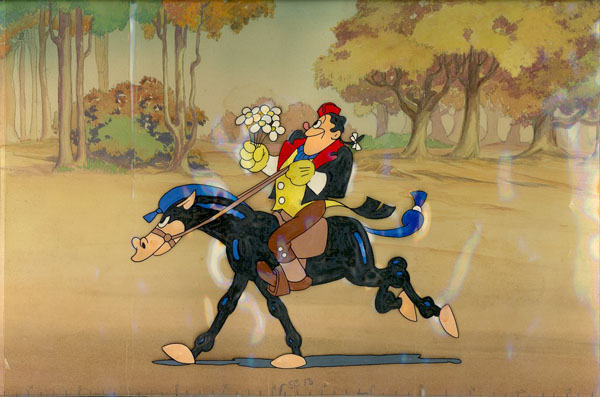
An original cel and background from Iwerks’ Comicolor short “The Headless Horseman” (1934)
Suspended Animation #291
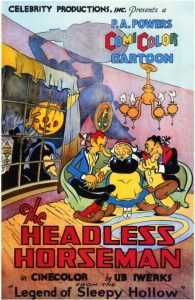 The Legend of Sleepy Hollow is a short story by American writer Washington Irving that was first published in 1820. Based on a German folk tale, Irving transplanted it to upstate New York in 1790.
The Legend of Sleepy Hollow is a short story by American writer Washington Irving that was first published in 1820. Based on a German folk tale, Irving transplanted it to upstate New York in 1790.
The earliest surviving film version of the story is a 1922 American silent movie called The Headless Horseman starring Will Rogers that supposedly offered some inspiration for the Disney version.
The first animated adaptation of the tale was a theatrical cartoon short created by Ub Iwerks and released to theaters in 1934 as part of his ComiColor series.
The Headless Horseman was a roughly eight minute cartoon released October 1st, 1934 and was directed by Iwerks with animation by Al Eugster, Shamus Culhane, Grim Natwick, Rudy Zamora and others. The musical score was by Carl Stalling who would later go on to be the musical director for Warner Brothers cartoons.
Except for the music and some sound effects, the cartoon is virtually a silent cartoon since there is no narration or dialog. The animation of the black silhouette of the Headless Horseman riding furiously on his steed is reused countless times during the story as is some other animation.
Work on an adaptation of the Washington Irving tale as a possible animated feature started at the Disney Studio in the early 1940s but was put on hold along with other features in development because of World War II.
After the war in late 1947, the studio was still financially struggling so Walt decided to pair the story with another adaptation being developed, The Wind in the Willows, as his final package feature. The Adventures of Ichabod and Mr. Toad was released October 5th, 1949.

Other money and time saving efforts included recyling some animation from The Old Mill (1937) like the cattails thumping and the reeds swaying. The character of Katrina Van Tassel used the same model sheet for the character Grace Martin from The Martins and the Coys segment from Make Mine Music (1946). Even Ichabod’s horse, Gunpowder, seemed to resemble Cyril Proudbottom who was Mr. Toad’s horse companion.
To further increase the possibilities of financial success, Walt decided to have the stories told by celebrity narrators. Actor Basil Rathbone’s distinctive British voice would tell the tale of writer Kenneth Grahame’s Mr. Toad and his misadventures while singer Bing Crosby would lighten up some of the frightening aspects of Ichabod’s story especially with some of his well-known, unscripted ad-libs like nicknaming the lead character “old Icky”.
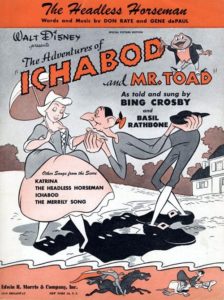 Oliver Wallace was the musical director for the film. When he wrote the score, he recorded himself whistling to show Ichabod trying to keep his composure even as he became more and more scared as he rode through the woods at night.
Oliver Wallace was the musical director for the film. When he wrote the score, he recorded himself whistling to show Ichabod trying to keep his composure even as he became more and more scared as he rode through the woods at night.
For the dance sequence, Wallace composed a song that was never used entitled Whoop-Ta-Doodle-Dey (“Roll up the carpet, shine the floor and dance like you never danced before. Whoop Ta Doodle Dey!”).
At one point, voice artist Thurl Ravenscroft with his deep, frightening voice was going to sing The Headless Horseman song instead of Crosby. It was decided that it would make it more consistent to have Crosby do everything except the women’s voices. Ravenscroft did record the song which was much creepier than Crosby’s interpretation and Disney decades later released it on CD.
Bea Benaderet, who voiced Katrina Van Tassel and Tilda, is best known as the voice of Betty Rubble on Hanna-Barbera’s The Flintstones. She also played in several 1960s television series including The Beverly Hillbillies and Petticoat Junction.
“The Headless Horseman” as well as the two other songs in the featurette was from composers Don Raye and Gene de Paul who also contributed songs to So Dear to My Heart and wrote the song “Beware the Jabberwock” for Alice in Wonderland that was not used.
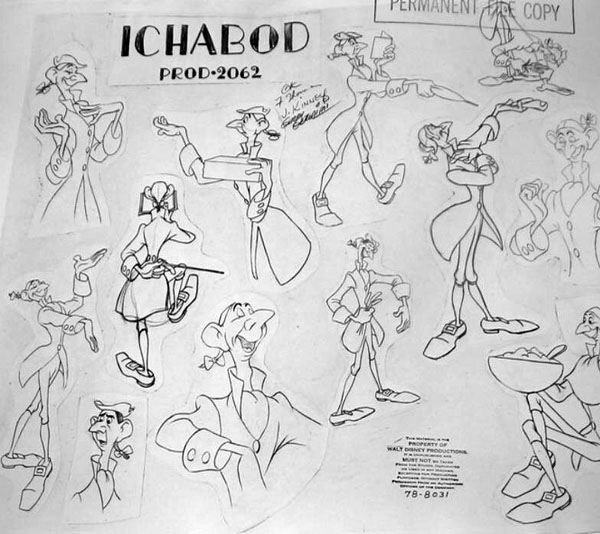
To capture the authentic feeling of the Hudson Valley country, Walt Disney personally visited the region around Tarrytown. The film depicts accurate details of clothing, buildings and landscape. The church shown during the opening narration was drawn to look like the actual Old Dutch Church built in the late 1660s in the Sleepy Hollow area.
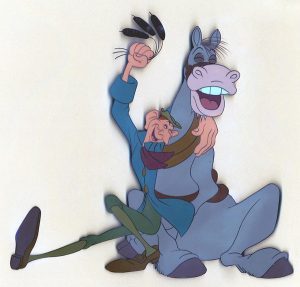 Ironically, the Disney animated featurette is considered one of the most faithful adaptations of the Irving story especially depicting Ichabod as a glutton and unsympathetic opportunist. However, that doesn’t mean that Disney didn’t add its own little embellishments to the story but essentially still stayed true to the “spirit” of the original.
Ironically, the Disney animated featurette is considered one of the most faithful adaptations of the Irving story especially depicting Ichabod as a glutton and unsympathetic opportunist. However, that doesn’t mean that Disney didn’t add its own little embellishments to the story but essentially still stayed true to the “spirit” of the original.
For instance, Halloween is never mentioned in the original story but Disney set the Van Tassel party in October and made it a Halloween party with the various guests chiming in about the various ghastly things that happen on that special night before getting to the Headless Horseman.
While it is clear that Irving intended Ichabod’s encounter with the horseman to be another prank by Brom Bones, the Disney film implies that he became entangled with an actual phantom.
Ichabod looks down into the neck of the horseman and finds nothing there but blackness. The horseman is less robust than Bones and the horse looks a little different from the one Bones rode earlier in the film and does not have a saddle.
However, as animators Frank Thomas and Ollie Johnston wrote, “The dangers in the woods of Sleepy Hollow are actually all in Ichabod’s imagination, but the audience was nervous because they saw what he saw rather than what was really there.”
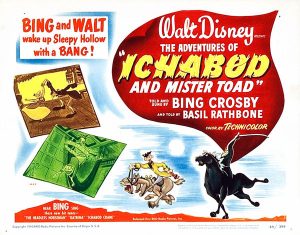 Animator Andreas Deja said that his work on the character of Gaston from Beauty and the Beast, was influenced by Brom Bones Animator Frank Thomas used his own experience from horse riding where he felt either ignored or stymied by the horse for animating Ichabod riding the plowhorse.
Animator Andreas Deja said that his work on the character of Gaston from Beauty and the Beast, was influenced by Brom Bones Animator Frank Thomas used his own experience from horse riding where he felt either ignored or stymied by the horse for animating Ichabod riding the plowhorse.
Thomas told writer Jim Fanning, “When I was animating Ichabod, he had the same sort of trouble that I had had. I felt he didn’t know anything about horses. The horse didn’t care about him. He didn’t care that he was in Sleepy Hollow, or whether there were ghosts. But Ichabod had this terrible apprehension about going through Sleepy Hollow and he had to use this horse. He would have been better off without a horse.”
The Headless Horseman was primarily animated by Woolie Reitherman along with John Sibley. It was the evocative concept artwork of Mary Blair and John Hench that inspired the overall “look” of the film.
Many of the animal sounds were done by Clarence Nash, who was the original voice of Donald Duck, and Ichabod’s screams were done by Pinto Colvig, the original voice of Goofy. Billy Bletcher provided the laugh of the Headless Horseman. Bletcher had provided the voices for Pegleg Pete and the Big Bad Wolf.
When The Legend of Sleepy Hollow was first run on the weekly television show on October 26th, 1955, to fill out the hour, a new fourteen minute animated segment about the life of Washington Irving was included.
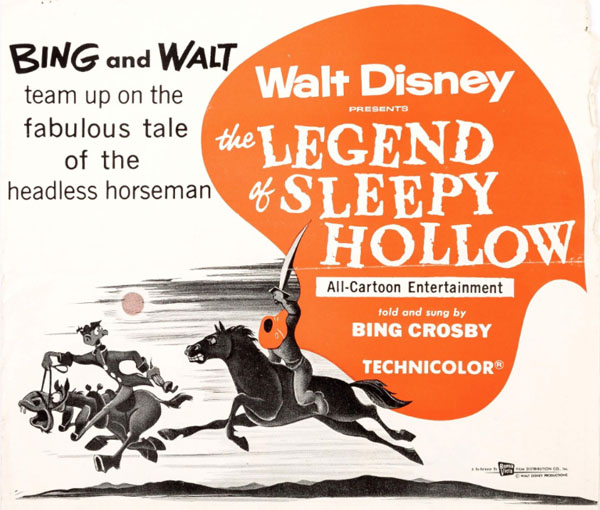
The Legend of Sleepy Hollow was released on its own to theaters as a 33-minute featurette in September 1963. This was the same edit presented on the Disneyland television series, minus the 14-minute prologue and the Walt Disney live-action host segments. This version was first released on VHS in 1982.
Time magazine wrote, “This lighthearted, fast-moving romp has inspired some of Disney’s most inventive draftsmanship and satire. The midnight chase through a clutching, echoing forest with the gangling, lily-livered schoolmaster in full flight before the Headless Horseman is a skillful blend of the hilarious and the horrible. It is Disney at his facile best.”


 Jim Korkis is an internationally respected animation historian who in recent years has devoted his attention to the many worlds of Disney. He was a columnist for a variety of animation magazines. With his former writing partner, John Cawley, he authored several animation related books including The Encyclopedia of Cartoon Superstars, How to Create Animation, Cartoon Confidential and Get Animated’s Animation Art Buyer’s Guide. He taught animation classes at the Disney Institute in Florida as well as instructing classes on acting and animation history for Disney Feature Animation: Florida.
Jim Korkis is an internationally respected animation historian who in recent years has devoted his attention to the many worlds of Disney. He was a columnist for a variety of animation magazines. With his former writing partner, John Cawley, he authored several animation related books including The Encyclopedia of Cartoon Superstars, How to Create Animation, Cartoon Confidential and Get Animated’s Animation Art Buyer’s Guide. He taught animation classes at the Disney Institute in Florida as well as instructing classes on acting and animation history for Disney Feature Animation: Florida.




















































“The animation of the black silhouette of the Headless Horseman… is reused countless times….” Well, not “countless” times. Four.
According to historian Richard Hofstadter (Anti-Intellectualism in American Life, 1963), Ichabod Crane was the first depiction of a schoolteacher in American literature, which gives you an idea of the low regard in which the profession was held in the early days of the republic. Notwithstanding my distaste for any story where a bully runs a cultured bookworm out of town and marries his sweetheart, I think “Sleepy Hollow” is one of the best segments from any of the Disney package features. “A skillful blend of the hilarious and the horrible” — Time got that right.
That said, I developed a morbid fear of the Headless Horseman after listening to the Thurl Ravenscroft recording of the song at a friend’s house when I was in first grade. (That voice may have sold a lot of Sugar Frosted Flakes. but in this context you’re right, it was truly frightening.) I used to worry that the Headless Horseman was lurking in dark rooms or in the basement, and I had nightmares about him. My father thought it might help if he read the original Washington Irving story to me at bedtime. Bad idea.
So I was relieved when I finally saw the cartoon as a young adult (at a Halloween party, as it happens) and found the climactic chase sequence funny and exciting, but not particularly scary. Thanks for writing about this classic and giving me the opportunity to see it once again. Happy Halloween!
Even now, the Headless Horseman leads the Halloween parade at Disney World – and it’s pretty spooky.
https://www.youtube.com/watch?v=04uPTBoZiUg
Love this film. The Iwerks version is cool too.
Awesomely appropriate post! Here’s a fun thing to do: go to 2:19 on the Headless Horseman short from the 1930s (use this link) and listen to 15 seconds:
https://www.youtube.com/watch?v=RZ949PoJuEw
Now, go to 2:32 on this link and listen for 15 seconds:
https://www.dailymotion.com/video/x6egt12
See the similarities? This “screwball theme”, developed by Carl Stalling in 1934 for the former cartoon, was reused for many Bugs and Elmer cartoons like this one, Robot Rabbit, and others!
A great cartoon! My dad took me and my younger brother to the movies. I watched it at the edge of the theatre seat. A clever mix of,humor, music and real fright.
I also loved the secondary characters, especially the enthusiastic Tildaand her dancing!
Billy Bletcher narrated the 1963 Disneyland album that introduced the Thurl Ravenscroft version of “The Headless Horseman” song. Both the Disneyland and Decca recordings are examined here:
https://cartoonresearch.com/index.php/walt-disneys-ichabod-or-the-legend-of-sleepy-hollow-on-records/
Don Raye and Gene DePaul also wrote the “Alice in Wonderland” song, “‘Twas Brillig.”
“Sleepy Hollow” was also half of the first episode of the animated TV series best known as Kenner’s “Famous Classic Tales” called “Tales of Washington Irving.” It was produced by API in Australia, which became Hanna-Barbera Pty. in 1972 with the series “The Funky Phantom.”
https://www.youtube.com/watch?v=VCH2e54zHXA&pbjreload=101
If I recollect with accuracy, one of the first all-CGI animated specials was an adaptation of the story. It was syndicated to local — or non-network, anyway — stations. The animation was unnatural and creepy when it wasn’t supposed to be, and the highlights were objects that morphed into skulls and the like. Don’t remember if this was before or after “Toy Story” raised the bar.
“Robot Carnival” had a sequence that wittily combined “Headless Horseman” with “Night on Bald Mountain”. Instead of a monstrous demon a giant robot summons machines to life, and a drunk on a scooter — the only human not home in bed — flees a pursuing robot. The nods to Disney were unmistakable and funny.
Note that “Make Mine Music” and “Melody Time” both end on unexpected emotional notes. In one, Willie the Whale’s dreams end in tragedy. In the other, a brokenhearted Pecos Bill returns to the animal world. Maybe that was purposeful. That might explain why “Ichabod and Mister Toad” sent audiences home with a Halloween scare instead logically closing on Toad’s Christmas battle and New Year’s airplane.
Some useful info, but one correction: Bea Benaderet isn’t in LEGEND OF SLEEPY HOLLOW (and Katrina doesn’t even speak; the chubby girl, Matilda on model sheets, just giggles, so could be one of Jud Conlon’s Rhythmaires who do the chorus work or who knows). That’s something that circulated on fan wikis relatively recently.
Keith Scott –
Where ar-r-r-e you?
Do you have any knowledge of this?
Incidentally, Katrina bears a close resemblance in facial features to Cinderella, released 1 year later.
And if that was the case, who can blame them?
Her bust aside, why is it called progress that animation resembling real females such as these has been replaced by the plastic Bratz dolls of Frozen?
Katrina, indeed, never even spoke, but, in addition to the above credits, Bea Benaderet, credited (however incorrectly), also worked steadily from 1943(?) through 1955(?) at WB …and a few other studios, I think. (MGM, I think, which would be likely how Hanna and Barbera got her for the FLINTSTONES, though I’m not sure…)
I enjoyed the HEADLESS HORSEMAN Disney cartoon, and I did check out the 1930s cartoon – and it does have Stalling’s music, and the later Bugs-Elmer tune! At 2:19!
Oliver Wallace’s score for this featurette has some great moments. The thumping, whirling orchestrations during the climactic Horseman chase sequence are probably some of the best of his career. There’s a real “horror” theme developed for the Horseman himself played in high, shrieking horns – calling back a bit to the classic Universal monster themes of old, particularly Franx Waxman’s growling Monster theme in “Bride of Frankenstein”, which Wallace actually played on as a session organist.
CGI is different than traditional, Kirby. And I never found the girls ugly at all.
I used to volunteer at the Philipsburg Manor Upper Mills historic site in Sleepy Hollow, directly across from the Old Dutch Church, and I can vouch for the authenticity of the depiction of the setting. The church was built in 1689 by Frederick Philipse for his tenant farmers. The church is still in operation today as a house of worship, and the nearby cemetery has familiar names on the gravestones, including Van Tassel. The road Ichabod was riding down was the “Old Albany Post Road,” now US Route 9, and the bridge was across the nearby Pocantico River.
I happened to watch the original “Planet of the Apes” movie last weekend, and I couldn’t help noticing that when we first see the apes on horseback, Jerry Goldsmith’s musical score features a ram’s horn playing an ascending figure almost exactly like the horn motif that Oliver Wallace assigned to the Headless Horseman. Coincidence? Yes, probably! It’s not unusual for different composers, working independently, to arrive at similar solutions to the same problem (for example, Dukas’s “The Sorcerer’s Apprentice” and Holst’s “Uranus, the Magician” from “The Planets”, in both of which the main theme is stated by staccato bassoons in quick triple time). Both Goldsmith and Wallace took a horn call associated with fox hunting and added dissonance to signify a horrifying pursuer on horseback — very clever and effective film scoring.
Did everybody notice all the eyes in the trees in the 1934 cell background?
Paul: Thank you for the insight regarding the horn motif – I wouldn’t necessarily have made the connection to horseback hunting, but the use of the horn does conjure up images of the cavalry, specifically a unit on horseback charging into battle – all rather appropriate for Ichabod’s mounted assassin.
Hi folks!
I’m looking for the song in the Headless Horseman Ubi Iwerks 1934 Comicolor version. The part where Ichabod dances with Kristin. What is the title of that song? Please help!!!
This story should not have much of the ridiculous zany material that I get tired seeing upon plus the ambiguity of the ending itself will really rattle every sensitive and autistic viewer who can’t quite understand the fate of Ichabod.